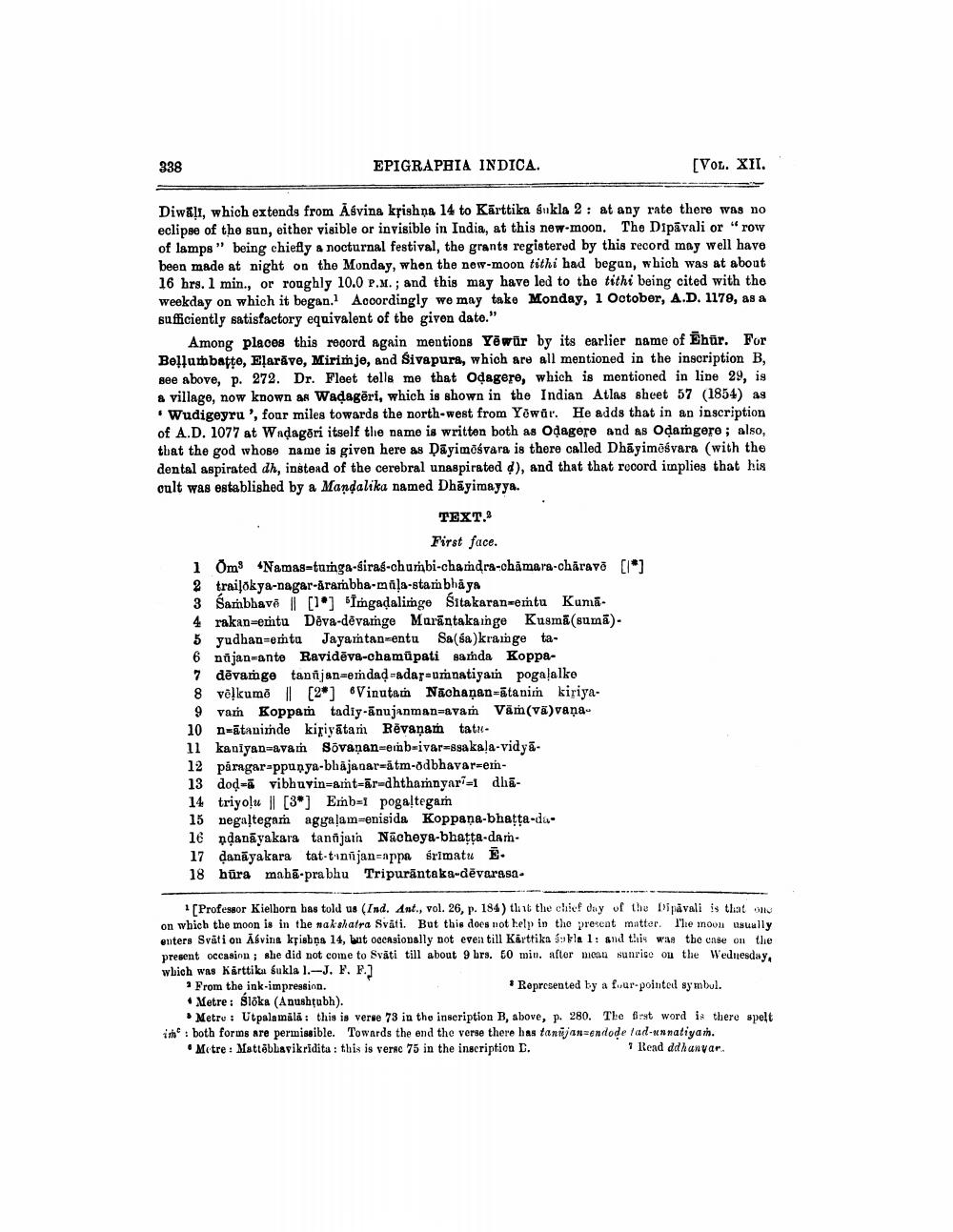________________
338
EPIGRAPHIA INDICA.
Diwali, which extends from Asvina krishna 14 to Kārttika Sukla 2: at any rate there was no eclipse of the sun, either visible or invisible in India, at this new-moon. The Dipavali or "row of lamps" being chiefly a nocturnal festival, the grants registered by this record may well have been made at night on the Monday, when the new-moon tithi had begun, which was at about 16 hrs. 1 min., or roughly 10.0 P.M.; and this may have led to the tithi being cited with the weekday on which it began. Accordingly we may take Monday, 1 October, A.D. 1179, as a sufficiently satisfactory equivalent of the given date."
Among places this record again mentions Yewür by its earlier name of Ehür. For Bellumbatte, Elarave, Mirim je, and Sivapura, which are all mentioned in the inscription B, see above, p. 272. Dr. Fleet tells me that Oḍagere, which is mentioned in line 29, is a village, now known as Waḍageri, which is shown in the Indian Atlas sheet 57 (1854) as Wudigeyru', four miles towards the north-west from Yowar. He adds that in an inscription of A.D. 1077 at Waḍageri itself the name is written both as Oḍagere and as Oḍamgere; also, that the god whose name is given here as Dayimosvara is there called Dhayimesvara (with the dental aspirated dh, instead of the cerebral unaspirated d), and that that record implies that his cult was established by a Mandalika named Dhayimayya.
TEXT.3
First face.
Namas-tumga-siras-chumbi-chandra-chamara-chārave [*]
1 Om
2 trailokya-nagar-arambha-mñla-stambhāya 3 Sambhave
[1] Imgaḍalimge Sitakaran-emtu Kumā.
4 rakan-emtu Deva-dēvamge Marantakainge Kusmā (sumā). 5 yudhan-emtu Jayamtan-entu Sa(sa)krainge ta
6 najan-ante Ravideva-chamüpati samda Koppa
7 dēvamge tanñjan-emdaḍ-adar-umnatiyam pogaļalke
8 vēlkumo [2] Vinutam Nachaṇan-atanim kiriya
9 vam Koppam tadiy-anujanman-avam Väm(vä) vaṇa
10 n-atanimde kiriyatam Revaņam tat
11 kaniyan-avam Sōvanan-emb-ivar-ssakala-vidya
[VOL. XII.
12 paragar-ppunya-bhajanar-atm-ödbhavar-em
13 dod- vibhuvin-amt-ar-dhthamnyar-1 dha
14 triyolu | [3] Emb-1 pogaltegam
15 negaltegam aggalam-enisida Koppana-bhaṭṭa-da
16 nḍanayakara tanñjain Nacheya-bhaṭṭa-dam
17 danayakara tat-tinijan-appa śrimatu E.
18 hüra maha-prabhu Tripurantaka-devarasa.
[Professor Kielhorn has told us (Ind. Ant., vol. 26, p. 184) that the chief day of the Dipavali is that one on which the moon is in the nakshatra Sväti. But this does not help in the present matter. The moon usually enters Svati on Asvina krishna 14, but occasionally not even till Kärttika skla 1: and this was the case on the present occasion; she did not come to Svati till about 9 hrs. 50 min. after mean sunrise on the Wednesday, which was Karttika śukla 1.-J. F. F.]
Represented by a four-pointed symbul.
2 From the ink-impression. Metre: ślōka (Anushtubh).
• Metre: Utpalamālā: this is verse 73 in the inscription B, above, p. 280. The first word is there spelt im both forms are permissible. Towards the end the verse there has tanujan-endoḍe tad-unnatiyam. Metre: Mattebhavikridita: this is verse 75 in the inscription D.
Read ddhanyar.




